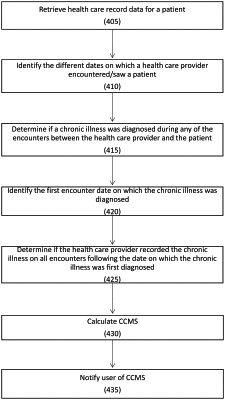| CPC G16H 10/60 (2018.01) | 18 Claims |

|
1. A method for identifying and conveying recordation and temporal inconsistencies in health care patient data pertaining to chronic illnesses, the method comprising the steps of:
accessing a plurality of distinct digital databases using one or more processors, wherein each digital database includes digital health care data in a native format dependent on a software platform used at each healthcare facility;
transforming native digital health care data stored in the database, using the one or more processors, to a standardized format in which the native digital health care data for at least a first patient is converted into a plurality of parsed data fields;
identifying, by the one or more processors, a chronic illness in the standardized digital health care data for the first patient;
identifying, by the one or more processors, a first health care encounter in which the chronic illness was recorded in the digital health care data for the first patient and determining a recorded stage of the chronic illness as diagnosed in the first encounter and recorded in the digital health care data for the first patient, wherein the stage of the chronic illness resides on a clinical continuum of the progression of the chronic illness;
upon determining the first health care encounter in which the chronic illness was recorded in the digital health care data for the first patient, identifying, by the one or more processors, temporally subsequent health care encounters with respect to the first health care encounter in which the chronic illness was recorded and determining, by the one or more processors, if the chronic illness was recorded in the digital health care data for the first patient for each temporally subsequent health care encounter;
determining, by the one or more processors, if the chronic illness was recorded in the digital health care data for the first patient for each temporally subsequent health care encounter;
as a result of determining that the chronic illness was not recorded in the digital health care data for the first patient for each temporally subsequent health care encounter, generating, by the one or more processors, an incompleteness alert, thereby informing a user that the digital health care data for the first patient is incomplete;
if the chronic illness was recorded in the digital health care data for the first patient for each temporally subsequent health care encounter, determining, by the one ore more processors, each stage of the chronic illness as diagnosed during each temporally subsequent health care encounter and recorded in the digital health care data for the first patient;
determining, by the one or more processors, if the stage of the chronic illness diagnosed for each temporally subsequent health care encounter has changed more than one stage along the clinical continuum in comparison to stages diagnosed for each prior health care encounter; and
as a result of determining that the stage of the chronic illness diagnosed for each temporally subsequent health care encounter has changed more than one stage along the clinical continuum in comparison to stages diagnosed for each prior health care encounter, generating, by the one or more processors, a temporal inconsistency alert, thereby informing the user that the digital health care data for the first patient is temporally inconsistent with the clinical continuum of the progression of the chronic illness.
|